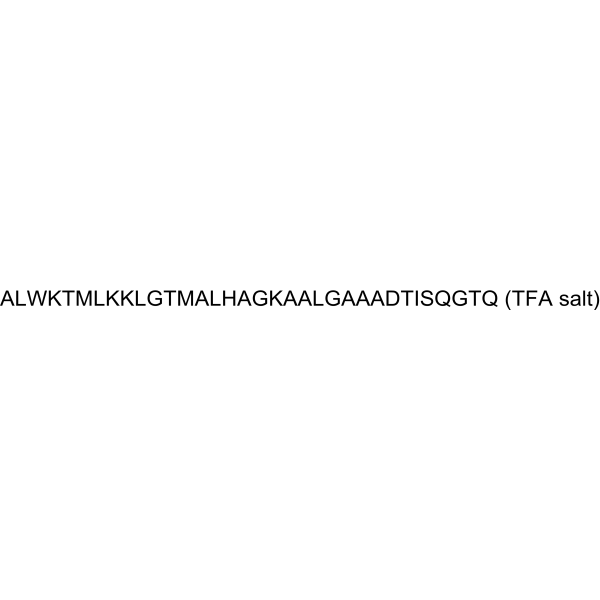Physicochemical Properties
| CAS # | 646451-06-1 |
| Related CAS # | Dermaseptin;136212-91-4 |
| Appearance | Typically exists as solid at room temperature |
| HS Tariff Code | 2934.99.9001 |
| Storage |
Powder-20°C 3 years 4°C 2 years In solvent -80°C 6 months -20°C 1 month Note: Please store this product in a sealed and protected environment (e.g. under nitrogen), avoid exposure to moisture and light. |
| Shipping Condition | Room temperature (This product is stable at ambient temperature for a few days during ordinary shipping and time spent in Customs) |
Biological Activity
| ln Vitro | Dermaseptin TFA is a thermostable, nonhemolytic, water-soluble peptide that exhibits strong antimicrobial action against pathogenic fungus at concentrations as low as micromolar. Dermaseptin TFA's 80% alpha-helical conformation was revealed by its circular dichroism spectra in hydrophobic media. Secondary structure predictions also suggested that Dermaseptin TFA can be arranged as an amphiphatic alpha-helix spanning residues 1-27, a structure that can disrupt membrane functions controlling water flux[1]. At micromolar concentrations, dermaseptin TFA attacks bacteria, protozoa, yeasts, and filamentous fungus with a lytic activity. The NH2-terminal alpha-helical amphipathic region, which spans residues 1–18 of the molecule, contains the molecular components accountable for Dermaseptin TFA's remarkable antibacterial potency[1]. Dermaseptin TFA (5-100 μg/ml; 48 hours) completely prevents the majority of microorganisms from growing, including filamentous fungus, yeasts, parasites, and both Gram-positive and Gram-negative bacteria[2]. Dermaseptin TFA (5-100 μg/ml; 48 hours) does not reduce human KJ3 cell growth, and guinea pig lymphocytes do not absorb Dermaseptin TFA treatment for 1 hour up to the highest dosage tested (200 μg/ml). At concentrations above 200 μg/ml, rabbit erythrocytes experience hemolysis after one hour of treatment, with 50% hemolysis occurring at 350 μg/ml[2]. Dermaseptin TFA exhibits antibacterial properties and possesses MIC values of 50 μg/ml, 100 μg/ml, 25 μg/ml, 15 μg/ml, and 50 μg/ml against Aeromonas cauiae, Pseudomonas aeroginusa, Escherichia coli, Enterococcus faecalis, L. mezicana (NF α strain), and Microsporum canis (IP1194), respectively[2]. |
| References |
[1]. Mor A, et al. Isolation, amino acid sequence, and synthesis of Dermaseptin TFA, a novel antimicrobial peptide of amphibian skin. Biochemistry. 1991 Sep 10;30(36):8824-30. [2]. Mor A, et al. The NH2-terminal alpha-helical domain 1-18 of Dermaseptin TFA is responsible for antimicrobial activity. J Biol Chem. 1994 Jan 21;269(3):1934-9. |
Solubility Data
| Solubility (In Vitro) | DMSO : 100 mg/mL |
| Solubility (In Vivo) |
Note: Listed below are some common formulations that may be used to formulate products with low water solubility (e.g. < 1 mg/mL), you may test these formulations using a minute amount of products to avoid loss of samples. Injection Formulations (e.g. IP/IV/IM/SC) Injection Formulation 1: DMSO : Tween 80: Saline = 10 : 5 : 85 (i.e. 100 μL DMSO stock solution → 50 μL Tween 80 → 850 μL Saline) *Preparation of saline: Dissolve 0.9 g of sodium chloride in 100 mL ddH ₂ O to obtain a clear solution. Injection Formulation 2: DMSO : PEG300 :Tween 80 : Saline = 10 : 40 : 5 : 45 (i.e. 100 μL DMSO → 400 μLPEG300 → 50 μL Tween 80 → 450 μL Saline) Injection Formulation 3: DMSO : Corn oil = 10 : 90 (i.e. 100 μL DMSO → 900 μL Corn oil) Example: Take the Injection Formulation 3 (DMSO : Corn oil = 10 : 90) as an example, if 1 mL of 2.5 mg/mL working solution is to be prepared, you can take 100 μL 25 mg/mL DMSO stock solution and add to 900 μL corn oil, mix well to obtain a clear or suspension solution (2.5 mg/mL, ready for use in animals). Injection Formulation 4: DMSO : 20% SBE-β-CD in saline = 10 : 90 [i.e. 100 μL DMSO → 900 μL (20% SBE-β-CD in saline)] *Preparation of 20% SBE-β-CD in Saline (4°C,1 week): Dissolve 2 g SBE-β-CD in 10 mL saline to obtain a clear solution. Injection Formulation 5: 2-Hydroxypropyl-β-cyclodextrin : Saline = 50 : 50 (i.e. 500 μL 2-Hydroxypropyl-β-cyclodextrin → 500 μL Saline) Injection Formulation 6: DMSO : PEG300 : castor oil : Saline = 5 : 10 : 20 : 65 (i.e. 50 μL DMSO → 100 μLPEG300 → 200 μL castor oil → 650 μL Saline) Injection Formulation 7: Ethanol : Cremophor : Saline = 10: 10 : 80 (i.e. 100 μL Ethanol → 100 μL Cremophor → 800 μL Saline) Injection Formulation 8: Dissolve in Cremophor/Ethanol (50 : 50), then diluted by Saline Injection Formulation 9: EtOH : Corn oil = 10 : 90 (i.e. 100 μL EtOH → 900 μL Corn oil) Injection Formulation 10: EtOH : PEG300:Tween 80 : Saline = 10 : 40 : 5 : 45 (i.e. 100 μL EtOH → 400 μLPEG300 → 50 μL Tween 80 → 450 μL Saline) Oral Formulations Oral Formulation 1: Suspend in 0.5% CMC Na (carboxymethylcellulose sodium) Oral Formulation 2: Suspend in 0.5% Carboxymethyl cellulose Example: Take the Oral Formulation 1 (Suspend in 0.5% CMC Na) as an example, if 100 mL of 2.5 mg/mL working solution is to be prepared, you can first prepare 0.5% CMC Na solution by measuring 0.5 g CMC Na and dissolve it in 100 mL ddH2O to obtain a clear solution; then add 250 mg of the product to 100 mL 0.5% CMC Na solution, to make the suspension solution (2.5 mg/mL, ready for use in animals). Oral Formulation 3: Dissolved in PEG400 Oral Formulation 4: Suspend in 0.2% Carboxymethyl cellulose Oral Formulation 5: Dissolve in 0.25% Tween 80 and 0.5% Carboxymethyl cellulose Oral Formulation 6: Mixing with food powders Note: Please be aware that the above formulations are for reference only. InvivoChem strongly recommends customers to read literature methods/protocols carefully before determining which formulation you should use for in vivo studies, as different compounds have different solubility properties and have to be formulated differently. (Please use freshly prepared in vivo formulations for optimal results.) |
